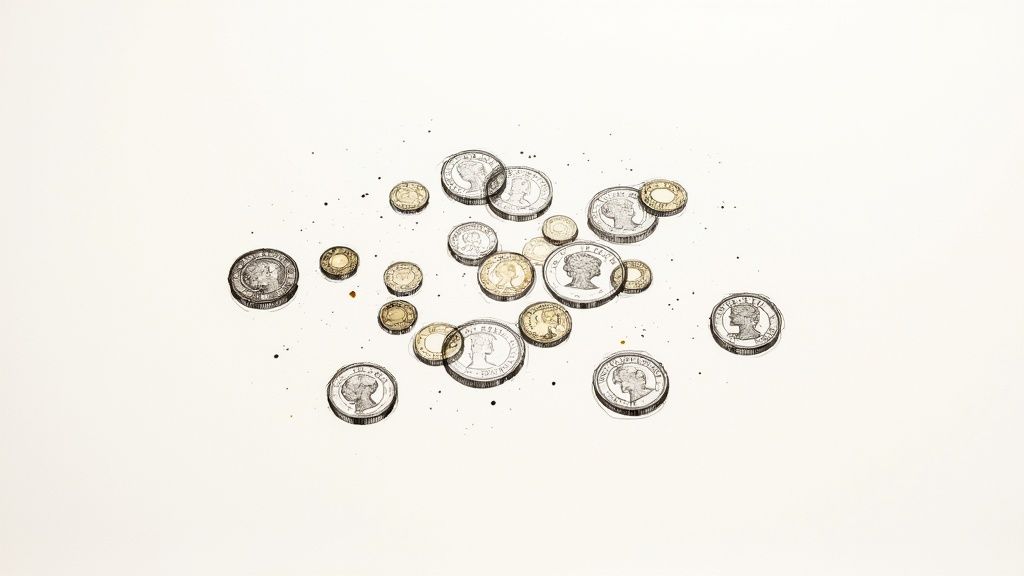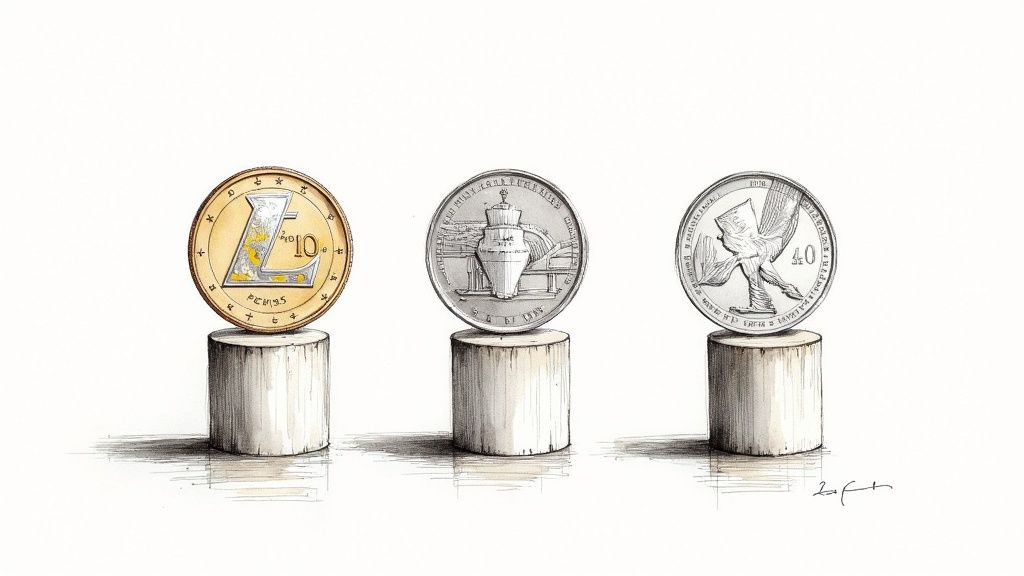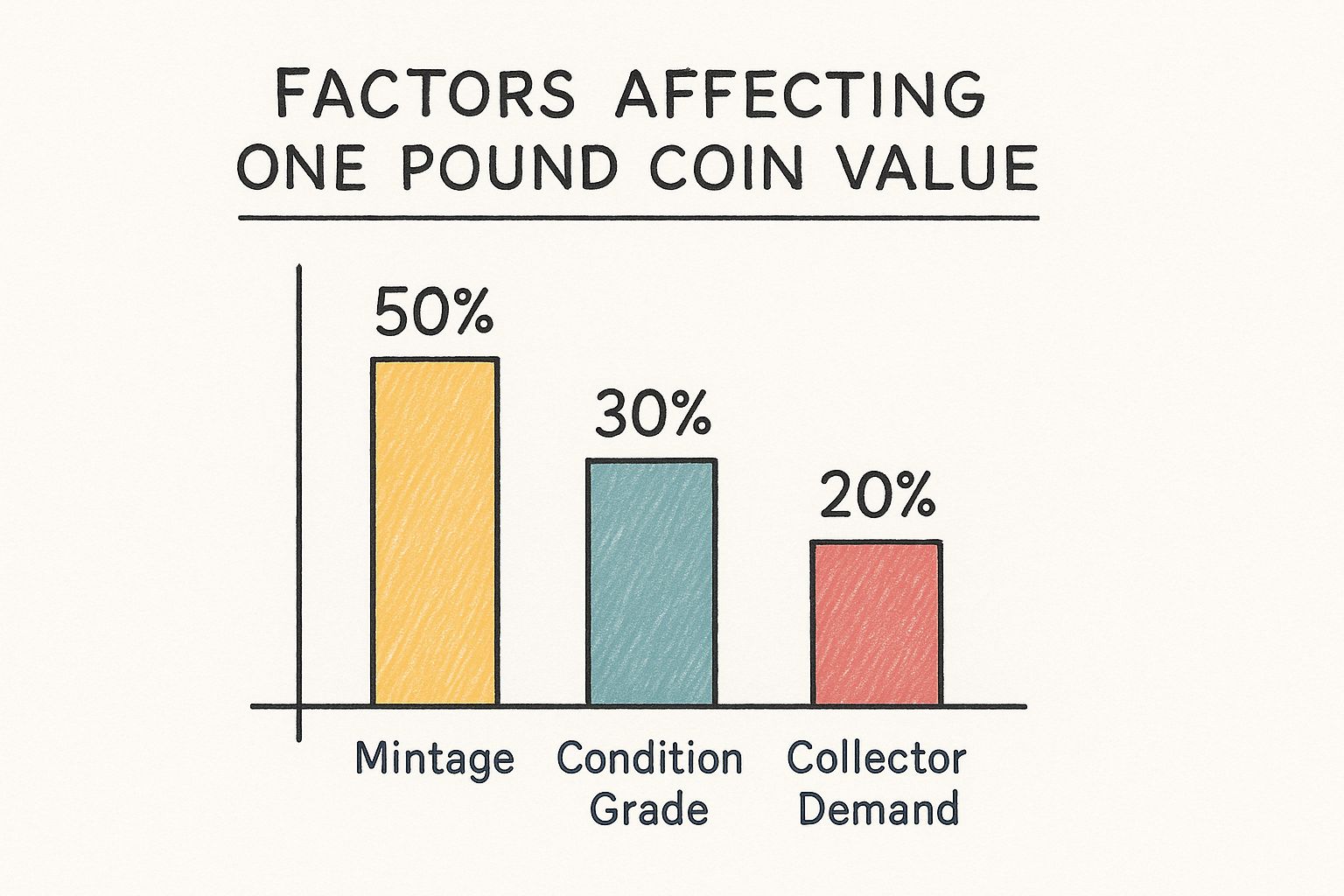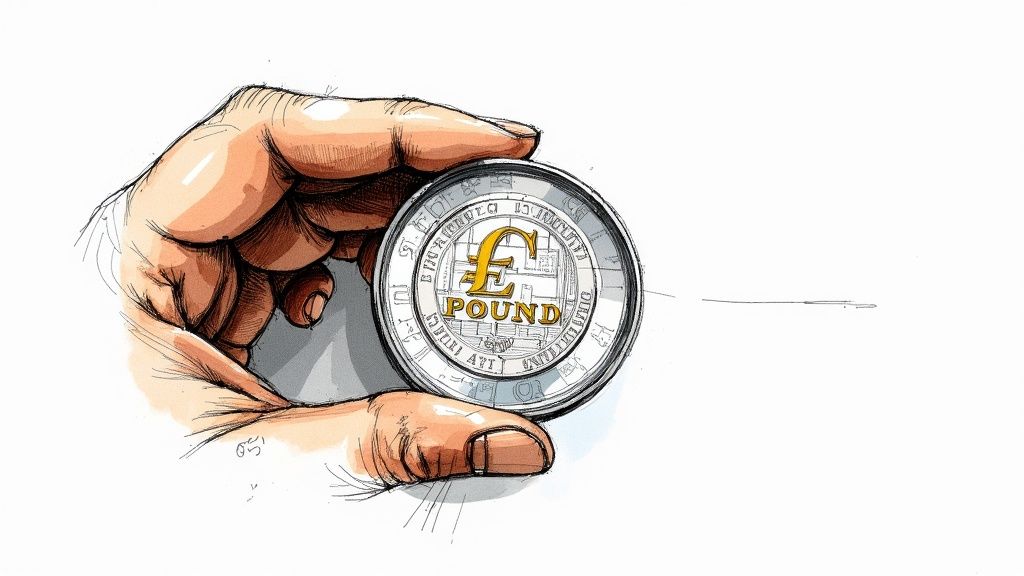That handful of change rattling around in your pocket could be worth a whole lot more than you think. In the world of coin collecting, some valuable one pound coins can fetch genuinely surprising sums. It all comes down to rare designs, low mintage numbers, and the occasional minting error that turns a standard £1 coin, particularly the old ‘round pound’, into a sought-after little treasure.
If you’ve ever wondered what makes a simple pound coin special, you're in the right place.
Do You Have Hidden Treasure in Your Pocket?

It’s so easy to just spend the coins that pass through our hands every day without a second glance. But for those in the know, that same handful of change is a trove of potential discoveries. The story of valuable pound coins isn't just about money; it’s about history, scarcity, and the pure thrill of the hunt.
The real collecting frenzy kicked off when the UK switched from the familiar round pound to the current 12-sided coin back in 2017. As the Royal Mint began withdrawing the older coins from circulation, people started to realise that some were far, far rarer than others. This was the perfect moment for ‘change checkers’ everywhere to start having a proper look through their savings jars.
Why Some Pounds Are Worth Pursuing
So, what elevates a normal coin to a collector's item? It usually boils down to a few key factors that create that magic mix of rarity and desirability. Getting to grips with these is the first step to spotting a hidden gem.
- Low Mintage Figures: This is the big one. The Royal Mint simply doesn't produce the same number of each design. When a particular coin has a very low production run, it automatically becomes scarce and, therefore, more sought-after.
- Minting Errors: Mistakes happen, even at a place as precise as the Royal Mint. Coins that escape with errors—like a misaligned design or the wrong inscription—are fascinating oddities that collectors absolutely prize.
- Commemorative Designs: Those special, limited-run designs celebrating events, famous figures, or historic places often have a lower mintage from the get-go, making them instant collectibles.
The sheer volume of old £1 coins that were once floating around means many are still hiding in plain sight. Just before the round pound was demonetised in 2017, there were an estimated 1.671 billion of them in circulation, each a tiny piece of UK history. You can dive deeper into the history of UK coinage on Wikipedia.
This guide will give you the knowledge to start identifying these special coins, turning an everyday transaction into a potential treasure hunt.
What Makes a Pound Coin Worth More Than a Pound?

Before you start tipping out your piggy bank, it helps to understand what turns an ordinary pound coin into a genuine collector's piece. Think of it as a treasure map – you need to know what the symbols mean to find the prize. The core ideas are surprisingly straightforward, all boiling down to rarity, mistakes, condition, and just how much other collectors want what you've got.
At its heart, what makes a coin valuable is simple economics: supply and demand. When the supply of a particular coin is incredibly low but the number of people desperate to add it to their collection is high, its value can't help but climb. This is exactly why the most valuable £1 coins are almost always the ones with the lowest mintage figures.
The Royal Mint strikes millions of coins every year, but it doesn't create every design in equal numbers. A coin with a mintage under two million is considered pretty scarce, but anything below one million is seen as exceptionally rare.
The Impact of Rarity and Minting Errors
The single most important factor that sets a coin's value is its mintage figure—that is, the total number of coins of a specific design and year that were ever produced. A low mintage creates instant scarcity. It stands to reason that a coin with only 900,000 in circulation is much harder to come across than one with 200 million, making it far more desirable.
Beyond this planned scarcity, you have the really exciting finds: the happy accidents. These are known as minting errors, which are mistakes made during the coin's production. These little oddities are highly prized by collectors simply because they are unique and were never meant to exist in the first place.
Some of the most valuable types of errors include:
- Mule Coins: This is what happens when the obverse (heads) die and the reverse (tails) die are mismatched. A famous example is the 2014 Royal Arms £1, which was accidentally struck with an obverse design meant for an Isle of Man coin.
- Die Errors: Tiny cracks or chips in the metal die used to stamp the coin can leave behind raised lines or odd blobs of metal on the coin's surface.
- Mis-strikes: If a coin isn't lined up perfectly during the striking process, it can lead to off-centre designs or even clipped, incomplete edges.
Condition and Collector Demand
The physical state of a coin plays a massive part in its value. A coin that has been jingling in pockets and purses for years will inevitably show scratches, dings, and a general loss of sharp detail. In stark contrast, a coin that looks like it just left the Mint is always going to be far more valuable.
Coin collectors use a grading scale to describe a coin's condition. A coin described as 'Uncirculated' (UNC) has no signs of wear and still has its original lustre, making it worth significantly more than a heavily worn or 'circulated' example.
Finally, the simple desire to complete a set can send the value of certain coins through the roof. When collectors are trying to assemble a full series, like the Capital Cities or Royal Arms designs, the rarest coin in that set becomes what’s known as a 'key date' coin. This intense demand for one specific piece can cause its market price to skyrocket, as everyone needs it to finish their collection.
The Most Wanted List of Valuable Pound Coins
Now that you know what makes a coin rare, it’s time to meet the stars of the show. Think of this as your field guide to the specific round pound coins every collector dreams of finding in their change. This is the ‘most wanted’ list for any serious enthusiast.
We’ll break down the most sought-after designs, point out their key features, and explain what makes each one so special. Keep this list handy—it’ll give you the confidence to sift through your coins and spot a genuine treasure when you see one.
The Undisputed Champion: The 2011 Edinburgh City
Topping our list is the undisputed king of rare round pounds: the 2011 Edinburgh City £1 coin. If you find only one valuable coin in your lifetime, you’ll want it to be this one. Its rarity isn't just collector folklore; it’s backed up by hard numbers.
What makes this coin so special is that it's the only round pound design with a mintage figure below one million. The Royal Mint produced just 935,000 of these coins for its 'Capital Cities of the UK' series, making it exceptionally scarce from the moment it was released. Its low circulation has consistently pushed its market value far beyond £1, with pristine examples fetching very tidy sums.
Other Key Coins to Watch For
While the Edinburgh coin is the crown jewel, several other round pounds are highly desirable thanks to their own low mintage figures. These are essential finds for anyone looking to build a worthwhile collection.
- 2011 Cardiff City: The sister coin to the Edinburgh design, the Cardiff City pound is the second-rarest in the Capital Cities series. With a mintage of 1,615,000, it's more common than its Scottish counterpart but still a fantastic find.
- 2010 London City: Representing England's capital, this coin had a slightly higher mintage of 2,635,000. While more were produced, its connection to London and its place in the popular Capital Cities set keeps demand high.
- 2008 Royal Arms: This one is interesting. The Royal Arms design is incredibly common overall, but the 2008 version is surprisingly scarce, with just 3,910,000 minted. It’s the one most people overlook, assuming it's just another standard coin.
Top 5 Most Valuable Round £1 Coins in Circulation
To help you spot these treasures at a glance, here is a quick reference table comparing the key features and estimated values of the most sought-after UK round pound coins.
| Coin (Year & Design) | Mintage Figure (Approx.) | Key Identifying Feature | Estimated Value (Circulated) |
|---|---|---|---|
| Edinburgh City (2011) | 935,000 | City crest with the motto "NISI DOMINUS FRUSTRA" | £25 - £40 |
| Cardiff City (2011) | 1,615,000 | City crest featuring a dragon and a leek | £15 - £25 |
| London City (2010) | 2,635,000 | Combined crests of the City of London Corporation | £8 - £12 |
| Royal Arms (2008) | 3,910,000 | Standard Royal Arms shield design (date is key) | £5 - £10 |
| Belfast City (2010) | 6,205,000 | Circular city crest with a ship and sea-horse | £4 - £7 |
This table serves as a great starting point, but remember that prices can fluctuate based on the coin's condition and the current market demand. Always do your own research before buying or selling.

As you can see, a coin’s mintage is by far the most significant factor in its value. However, its physical condition and the level of collector demand also play crucial roles. To dig deeper and see what else might be hiding in your pocket, check out our comprehensive guide on other rare one pound coins.
How to Inspect and Grade Your Coins

Finding a potentially valuable one pound coin is a thrilling moment, but that initial excitement is just the first step. To really understand what you're holding, you need to learn how to examine it like a seasoned collector. Don't worry, this process isn't complicated; it's all about looking closely and knowing what to look for.
The very first thing to do is simple verification. Grab the coin and cross-reference its date and design with a trusted source, like the Royal Mint's website or a reliable coin catalogue. This quick check confirms you’ve actually got a scarce issue, like the 2008 Royal Arms, and not just a more common year that looks similar.
Once you know what you have, the real hunt begins. Now you're on the lookout for the tiny imperfections and unique quirks that can transform a standard coin into a collector's prize. This is where a simple magnifying glass becomes your best friend, revealing details completely invisible to the naked eye.
Spotting Minting Errors
Minting errors are those fascinating little mistakes that happened during the coin's production. These aren't just damage; they are unique features from the minting process that can make a coin a one-of-a-kind collectible. You’ll need good lighting and that magnifying glass to spot them effectively.
Keep an eye out for these common tell-tale signs:
- Misaligned Text: Check the edge inscription carefully. Is the text perfectly centred, or is it struck off-kilter and wandering a bit?
- Die Cracks: These show up as fine, raised lines on the coin's surface. They're caused by a tiny crack in the die that was used to stamp the coin.
- Rotation Errors: Hold the coin by its edges with the Queen's head upright. Now, flip it over vertically (from top to bottom). The design on the other side should also be upright. If it's tilted at an angle, you've found a rotation error.
Proper handling is absolutely crucial to preserve a coin's condition. Always hold your coins by their edges, pinched between your thumb and forefinger. Touching the flat faces can leave behind oils and fingerprints that cause permanent, irreversible damage over time.
Understanding the Basics of Grading
The physical condition of your coin, known as its grade, has a massive impact on its final value. Grading is simply a way to describe how much wear and tear a coin has suffered since it left the mint. For anyone serious about collecting, it's essential to monitor your coin grading skills so you can accurately assess any potential finds.
While professional grading is a complex science, you can use a simplified scale to get a pretty good idea of your coin's condition:
- Uncirculated (UNC): This coin looks brand new, as if it just rolled off the production line. It has its original shine (lustre) and absolutely no visible signs of wear or scratches. These are always the most valuable.
- Very Fine (VF): The coin shows only light wear, mostly on the highest points of the design. All the major details are still sharp, and you can still see some of that original mint lustre.
- Fine (F): The design is still clear, but there's noticeable wear across the entire coin. Many of the finer details, like the strands of hair in the portrait or patterns on a shield, have started to go flat.
By combining careful inspection with a basic understanding of grading, you can start to accurately assess your finds and uncover the true potential of the valuable one pound coins sitting in your collection.
A Practical Guide to Buying and Selling Coins
That thrilling moment when you realise you’ve found one of the UK’s most valuable one pound coins is brilliant, but what’s the next step? For many, the collector's market can feel like a bit of a minefield. But with the right approach, you can buy or sell your coins with confidence. It all comes down to choosing the right venue and knowing how to present your coin properly.
Choosing Where to Sell
When it comes to selling, your two main routes are online marketplaces or a specialised coin dealer.
Marketplaces like eBay can be fantastic for reaching a massive audience. More eyes mean more potential bidders, which can sometimes push the final price up. The trade-off is that you’re in the driver's seat for the entire process – from taking photos and writing descriptions to packing and posting. And don't forget the platform fees, which will take a slice of your final sale price.
Going to a specialised dealer is often a much simpler and faster affair. They bring the expertise, and the sale is usually quick and straightforward. While their offer might be a little less than the absolute peak price you could achieve at auction (they need to make a profit, after all), you get security, expert appraisal, and immediate payment. If you have more than just a single coin, it's well worth looking into the process of selling a coin collection through a trusted expert.
Creating a Listing That Sells
If you decide the online route is for you, think of your listing as your shop window. You need to build trust and show off your coin's best features to attract serious buyers and get the price it deserves. Good photos are not just a nice-to-have; they’re essential.
- Lighting is Everything: Use bright, natural light but avoid direct sun, which causes glare. An overcast day by a window is perfect.
- Show Both Sides: You absolutely must have clear pictures of the obverse (the Queen's head) and the reverse (the main design).
- Zoom In on the Details: Get close-up shots of the date, any mint marks, and especially any unique features or errors.
- Be Honest: Don't try to hide any scratches or wear. Photograph them clearly. Buyers appreciate honesty and will trust you more for it.
Your description needs to be just as clear. State the coin's year, design, and its condition – using the grading terms we covered earlier gives you instant credibility. Tossing in the mintage figure is another great touch that shows you've done your homework.
How to Be a Smart Buyer
On the other side of the transaction, buying requires a healthy dose of caution. The goal is to avoid fakes and not get carried away in a bidding war. Before you even think about placing a bid, a little prep work goes a long way.
Here's the golden rule of collecting: if a deal looks too good to be true, it almost certainly is. A supposedly rare 2011 Edinburgh £1 on offer for just a couple of quid should set alarm bells ringing.
First, check out the seller. What does their feedback look like? Do they have a history of positive reviews from other coin buyers? A long-standing account with happy customers is a great sign.
Next, get a feel for the market. Search for the same coin in a similar condition and see what it has sold for recently. This gives you a realistic benchmark for its value and stops you from overpaying in the excitement of an auction. A bit of research and a sensible head will help you build a fantastic collection you can be proud of.
Beyond Face Value: The Story Your Coins Tell
Looking at your collection of valuable one pound coins just in terms of rarity and condition is really only seeing half the picture. Each coin is more than just something to collect; it's a tangible piece of the UK's economic history, a metal snapshot from a specific moment in time.
Think about a pound coin from 1983. Sure, its face value is £1, but its purchasing power—what you could actually go out and buy with it—was completely different back then. This is the real story your coins tell, connecting your hobby to the much bigger narrative of money, value, and inflation over the decades.
A Window into Economic History
Grasping this idea completely changes how you see your collection. A coin stops being just a static object and becomes an artefact that represents a specific economic environment. The designs, the metals used, and even their perceived worth all reflect the priorities and financial realities of their era.
A coin from the 1980s comes from a period of different wages, prices, and economic outlooks compared to one minted today. This shift in value, driven by inflation, adds a rich, fascinating layer to the act of collecting.
This perspective turns a simple hunt for rare dates into a much deeper appreciation for the forces that shape our currency. Your collection basically becomes a timeline you can hold in your hand, charting the economic journey of the nation.
For instance, the change in the British pound's purchasing power has been nothing short of dramatic. A pound in 1926 had the buying power of roughly £78.11 in today's money. That's an incredible shift, showing how inflation has eroded its value by nearly 99% over the last century. It really highlights how each coin in your collection captures a unique moment in economic history. You can explore these fascinating long-term inflation trends for the UK pound to see just how much things have changed.
A Few Common Questions About Valuable Pound Coins
Dipping your toes into the world of coin collecting can bring up all sorts of questions, especially when you’re just getting started. To help clear up a few common sticking points and build on what we’ve already covered, here are some quick and simple answers to the queries that pop up most often.
Are the Old Round Pound Coins Still Legal Tender?
The short answer is no. The classic round £1 coin was officially taken out of circulation—or demonetised—on 15 October 2017. This means you can't use them in shops anymore.
Don't just toss them, though! Many major UK banks and even the Post Office will still let you deposit them straight into your bank account. Before you do, it's always worth giving them a once-over for any rare dates or designs, like the 2011 Edinburgh coin we talked about.
How Much Is the 2016 Nations of the Crown Coin Worth?
The 2016 'Nations of the Crown' £1 coin has a special place in history as the very last round pound ever issued for circulation. The design, created by 15-year-old David Pearce, cleverly features the four floral emblems of the UK's home nations.
Despite its historical significance, this coin is incredibly common. A massive 230 million were minted, so it's generally only worth its face value. The only exception would be a perfect, uncirculated example that has come from a special collector's set.
A ‘mule’ coin is a fascinating and often valuable type of minting error. It happens when the obverse (heads) and reverse (tails) dies used to strike a coin were never meant to be paired together. These mismatched coins are prized by collectors precisely because of their accidental nature.
One of the most famous £1 mules is the 2014 Royal Arms coin. A small number of these were accidentally struck using an obverse die that was intended for an Isle of Man coin. Finding a genuine mule in your change is an exceptionally rare treat, but it’s a truly rewarding find for any collector.
Ready to start or expand your collection? Cavalier Coins Ltd offers an extensive selection of rare and fascinating coins from the UK and around the world. Explore our collection and find your next treasure today at https://www.cavaliercoins.com.

